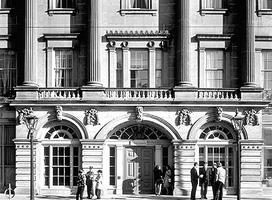
Eric Ross Arthur, architect, author, educator, heritage conservationist (b at Dunedin, New Zealand 1 July 1898; d at Toronto, Canada 1 Nov. 1982). Eldest of five sons of Frederick and Jean Arthur, he attended Otago Boys High School, where he received the New Zealand Art Society medal for drawing. He received his early architectural training in Dunedin (1917-18) with Arts & Crafts practitioner Basil Hooper. In 1918 Arthur enlisted with the New Zealand Rifle Brigade, arriving in England as the Armistice was declared. He enrolled at the University of Liverpool, School of Architecture (1919) under Sir Charles Herbert Reilly, whose Beaux-Arts curriculum was influenced by American-style classicism.
Arthur was awarded the Lord Kitchener National Memorial Scholarship (1919), the Lord Leverhulme Prize in civic design and architecture (1919, 1922) and the Holt Travelling Scholarship (1921), which allowed him to visit London, Berlin and Paris, including the École des Beaux-Arts. He earned a BArch with Hons. and Cert. in Civic Design (1922) and an MA (1926). After graduation he was employed in the office of Sir Edwin Lutyens and Sir Aston Webb, London, England, where he assisted William Naseby Adams in the design of Britannic (now Lutyens) House for the Anglo-Persian Oil Company. The two also competed successfully for the War Memorial, Dewsbury (1923).
Recruited to teach design at the University of Toronto, School of Architecture (September 1923), Arthur was among the first in Canada to teach the Modern movement, setting the stage for contemporary architecture in Canada. Under his guidance the School instituted a system of prizes and scholarships in design, and established two annual invited lectures as fora for the leading lights of the Modern movement. Arthur also introduced a staff-student committee to select speakers and advise on School decisions.
The Ontario Association of Architects granted Arthur a licence to practise (1929) and he entered into a series of partnerships, with Anthony Adamson (1929-34); with William Eric Fleury, George H. Piersol and Robert Gordon Calvert (1938-49); and with Fleury and Stanley Bennett Barclay (1949-65). In collaboration with his students Arthur entered the design competition for the Headquarters of the Royal Institute of British Architects, Portman Place (1932). His most prolific corporate commissions were those undertaken for Canada Packers, 20 in all between 1929 and 1965. His Canada Packers plant, Edmonton, executed in a simple modernist idiom, won a Gold Medal at the Exhibition of Architecture and Allied Arts (1937). Arthur also designed a house for Canada Packers president James Stanley McLean, in collaboration with George, Moorhouse & King (1929). During the course of his career Arthur planned over 100 projects, including Wymilwood, the Students' Union building for Victoria University, Toronto (Fleury & Arthur, 1954).
Arthur was a vocal advocate of excellence in architecture as editor of the Royal Architectural Institute of Canada Journal (1927-49), in a brief to the Massey Commission (1951), and as professional advisor and chairman of the jury for the new Toronto City Hall competition (1957), which chose an innovative design by Viljo Revell.
In addition to his interest in modernism, Arthur was deeply committed to Heritage Conservation. He published a series of articles on the early architecture of Ontario (1927-29), organized a photographic survey of 1400 pre-1840 Ontario buildings (1926-31), introduced a Measured Drawings project for his students to document vernacular architecture across the province (1920s-1966) for deposit with the Archives of Ontario and the National Archives of Canada (now part of the Canadian Inventory of Historic Building Division), and arranged for the Department of Northern Affairs and Natural Resources to sponsor a program to document historic buildings in Ontario (1960). This program was later extended to other regions of the country.
Arthur was a founding member of the Architectural Conservancy of Ontario (1932). He purchased the Barnum House in Grafton to assure its preservation (1939) and acted as restoration consultant on many projects, including St. Andrew's Presbyterian Church, Niagara-on-the-Lake (1938), St Lawrence Hall, Toronto (1967-68), University College, Unievrsity of Toronto (1964-1973), and the Enoch Turner Schoolhouse, in Toronto (1971). He published eleven books on heritage topics, the most influential of which was Toronto: No Mean City (1964).
Arthur's honours included the University of Alberta Gold Medal for distinguished service to the arts and architecture in Canada (1956), LLD honoris causa, University of Manitoba (1959), City of Toronto Award of Merit for distinguished public service (1965), American Association of State and Local History Award for outstanding contribution to local history (1965), Centennial Medal for Confederation Memorial Centre, Charlottetown (1967), Canada Council Medal for outstanding cultural achievement (1968), and Companion of the Order of Canada (1968), and an honorary degree from the University of Guelph (1981).
Arthur was a member of the York Club and the Vitruvian Society. He travelled extensively, including to Britain with the Merchant Marine (1941) and by canoe down the Albany River (1948). He also served as corresponding secretary for UNESCO for more than twenty years. Arthur retired from teaching in 1966, but served as consultant for the British Columbia Wood Trade Organization and Stelco, including its publication Stelco Trend (1961-82).
Arthur was married to fellow architectural student Doris Deborah Debert in 1923. They had two children Paul and Jean.

 Share on Facebook
Share on Facebook Share on X
Share on X Share by Email
Share by Email Share on Google Classroom
Share on Google Classroom


